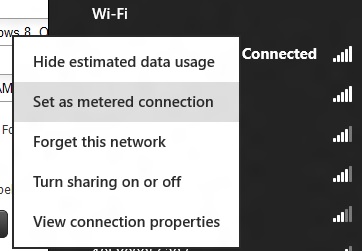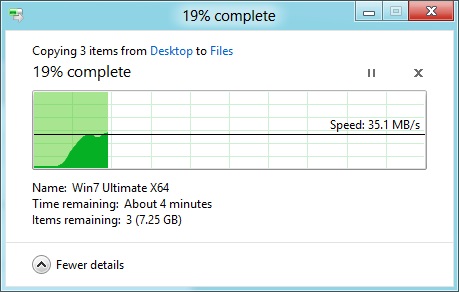In-Depth with the Windows 8 Consumer Preview
by Andrew Cunningham, Ryan Smith, Kristian Vättö & Jarred Walton on March 9, 2012 10:30 AM EST- Posted in
- Microsoft
- Operating Systems
- Windows
- Windows 8
Networking improvements
The widespread adoption of cellular connectivity in an increasing number of laptops and tablets have made our computing devices more mobile than ever before, but it has also given rise to an age of data caps, bandwidth throttling, and exorbitant prices from carriers. In the United States, unlimited data plans are a thing of the past, and as such any operating system worth its salt is going to have to be more careful about what, where, when, and how it sends and receives data.
To that end, Microsoft has instituted several features in Windows 8 that both users and developers can utilize to measure data usage and keep it in check.

Thanks to class drivers (which we'll discuss in just a minute), mobile broadband chips are treated as first-class devices in Windows 8—the same as wi-fi, ethernet, Bluetooth, and USB 3.0, among others—which means that broadband adapters can be turned on and off through the Windows GUI in the same way that wi-fi and Bluetooth now are, and there's also an Airplane Mode can turn all of it off in one swoop, just like on a smartphone (see above). As on phones, Windows will automatically prioritize wi-fi networks when both wi-fi and cellular are available.
This increased integration into Windows has many benefits: if your laptop or tablet has a SIM card installed, Windows can automatically detect which carrier it's associated with and download any available mobile broadband app from the Windows store, and carrier-unlocked laptops and tablets can choose between multiple cellular carriers if the hardware supports it. Windows also offers estimated data usage figures when connected to cellular networks, and when connected to a cellular network the OS will adjust its default behaviors to conserve bandwidth (for example, deferring the automatic downloading and installation of Windows updates until wi-fi is available).

Though it is off by default, these bandwidth conservation features can also be enabled for traditional wired and wireless network connections by right-clicking the name of the network you're connected to. While on a metered network, apps can now use new APIs to force network-aware Metro apps to use less data when possible (another example: using a low-bandwidth movie stream rather than a high bandwidth one). Network-aware Metro apps are required to use these APIs, and users can check how much bandwidth apps are using (both on metered and non-metered networks) in the new Task Manager.
Improvements to networking in Windows also extend to file copying, namely the SMB networked file sharing protocol. In Windows 8, the protocol can now shift dynamically between different network adapters during copy operations so that it always uses the fastest possible connection to transfer files. To demonstrate, I began copying a few gigabytes of data to a fileserver on my home network using a slow wireless G connection:

Then, without pausing the file copy operation or disabling my wireless card, I plugged the laptop into the network with a gigabit ethernet cable:

As you can see, as soon as Windows detected a faster network interface, it without complaint began copying the files using the faster connection. I then unplugged the laptop from the ethernet cable:

Again without issue, it switched back to the slower connection and continued copying the files. While this flexibility is impressive, it should be noted that it can only kick in for file transfers between two Windows 8 (or Windows Server 8) computers.
Drivers
Windows Vista broke a lot of things when it launched, and drivers was a big one—at least part of Vista’s caustic reputation was earned because third-party drivers made the platform so unstable. Since then, Microsoft has been committed to maintaining driver compatibility between Windows versions. During my testing, I found that the vast majority of drivers certified for Windows Vista and Windows 7 worked without issue in Windows 8, lending credence to Microsoft’s assertion that Windows 8 will be able to run on anything that could run Windows 7.
Windows 8’s main innovation is the sheer number of class drivers it introduces. For the un-indoctrinated, class drivers target defined specifications rather than specific hardware. Class drivers are the reason you don’t need to install specific software to run things like mice, keyboards, or USB 2.0 controllers.
Windows 8 adds new class drivers for things like USB 3.0 controllers, printers, motion sensors, mobile broadband cards, and a few others, all of which should be very useful on modern systems running Windows 8 or Windows on ARM. My personal experience extends to the USB 3.0 driver, which worked just fine for the oddball Fresco controller in my Intel desktop board, and the printer drivers, which worked well for a variety of local and networked printers I connected to from my various Windows 8 testbeds.
Microsoft also provides a new basic display driver in Windows 8. While the old generic display driver ran using the Aero Basic theme, the new driver appears to have basic support for Aero effects and transparencies. Among the systems that I tested, only a few had GPU-specific graphics drivers that installed from the DVD. While this may not be true of the RTM version of Windows 8, it looks like Microsoft is scaling back on the number of included graphics drivers to save space—you’d best check Windows Update or your manufacturer’s web site for updated graphics drivers, if they’re not included.










286 Comments
View All Comments
imaheadcase - Friday, March 9, 2012 - link
Its windows ME upgrade to win 7. Nothing but GUI changes that will effect anyone.Looks like win 8 is just a way to merge the OS to all devices besides Desktop. Seems more a dev helper OS than a consumer helper OS.
B3an - Monday, March 12, 2012 - link
*face palm*You didn't even read the article did you.
Just counting the desktop changes alone, Win 8 has far more changes than 7 did from Vista.
DrApop - Friday, March 9, 2012 - link
Well, I better go buy me a copy of windows 7 before the stop selling it. The last thing I want to do is slap this ugly windows 8 UI system on my computer!Everyone seems to be acting like this is such an innovation from microsoft, putting the same OS on phone, tablet, and now desk top. Does anyone remember Windows CE on a PDA?
Anyway, some of you love the UI, while I and others do not. We shall see how it goes when it goes on the desktop. All I know is that Microsoft had better start training up a huge slew of CS personnel because they are going have a whole bunch of people calling their CS support line when the win 8 users are unable to find anything on their computer. It is going to be a really mess for about 6-12 months. But I'm sure MS will charge for CS so that will be another revenue stream for them.
TEAMSWITCHER - Friday, March 9, 2012 - link
Given the immense negative feedback there is simply no way Microsoft can afford to launch Windows 8. They have made a massive tactical error - by tying the Metro interface to the classic Windows desktop they have assured it's failure. Desktop users don't want it - and with all the negative feedback - tablet shoppers won't either. Why should they?I really expected more from Microsoft. They have done so many good things in Windows 7. How could they possibly want to mess with that success? Is the iPad so threatening? I don't understand how they could let this happen.
londiste - Friday, March 9, 2012 - link
> Windows 8 adds new class drivers for things like USB 3.0 controllers, printers, motion sensors,wait... what - motion sensors?
did you happen to try using kinect at any stage of playing around with w8?
:)
Andrew.a.cunningham - Friday, March 9, 2012 - link
I don't have one, unfortunately. :-)The motion sensors the article refers to are things like accelerometers and gyrometers - mostly hardware you'll find in tablets.
Scali - Friday, March 9, 2012 - link
"Linux advocates act as though Microsoft has taken something away in disallowing third-party OSes on WOA devices, when in fact they’re disabling nothing that hasn’t already been disabled on most competing tablets."Nice to see someone telling it like it is for a change.
mcnabney - Friday, March 9, 2012 - link
It looks like backup functionality is only supported for DVDs and local drives in Premium. If you want to backup your system across a home network it looks like you have to upgrade to Professional. I guess MS needs more cash from people who are clever enough to make sure backups aren't stored ON THE COMPUTER NEEDING THE BACKUP.Tried the preview. Hated Metro. My multimonitor setup looks retarded with Metro running. Also had some compatibility issues relating to Steam/games. I'm pretty happy with Win7 and am unlikely to spend a bunch of money upgrading my numerous computers for marginal at best gains.
Andrew.a.cunningham - Friday, March 9, 2012 - link
Yeah, that's how it is in Windows 7, which seriously limits the feature's usefulness. We're still waiting to see how the Windows 8 product editions break down, and what features are present/excluded from each version.IlllI - Friday, March 9, 2012 - link
windows 7 will be the last version they ever use. the learning curve to windows 8 is too steep and i can't keep trying to teach them, especially with their memory not being as good as it once was.